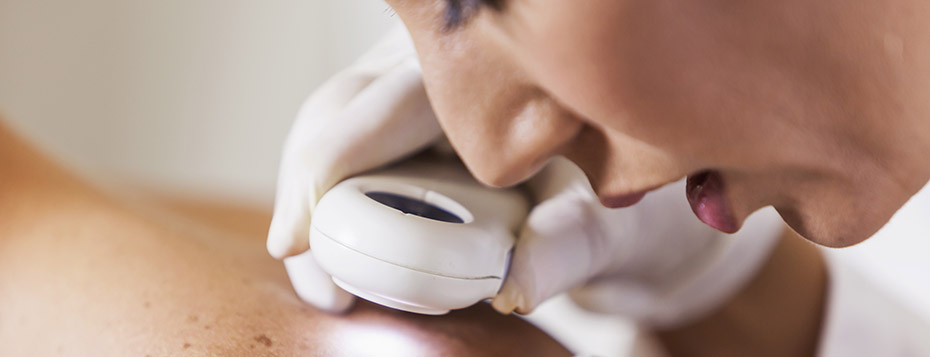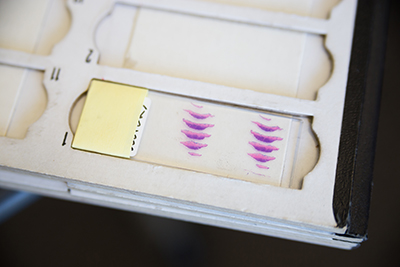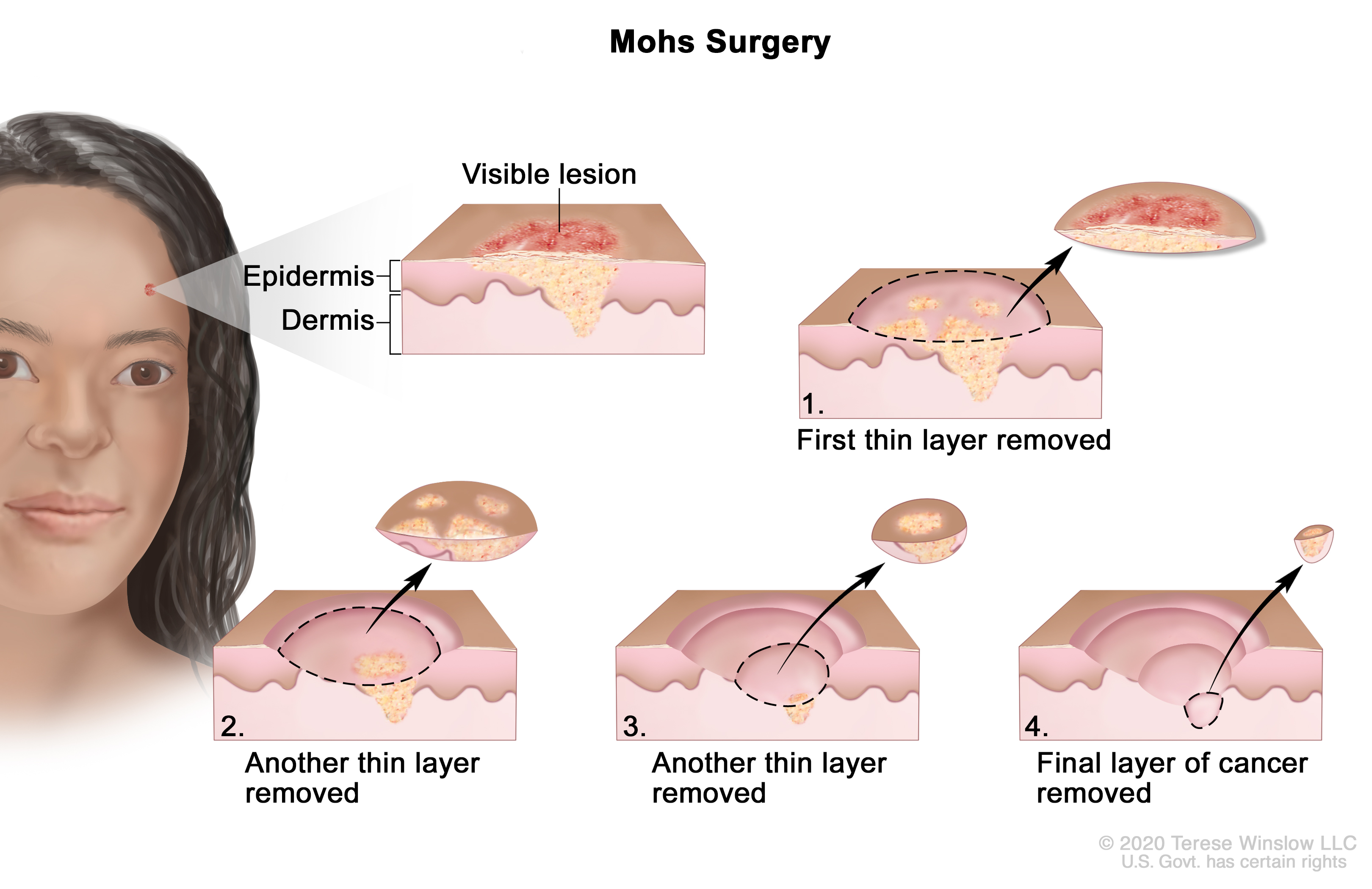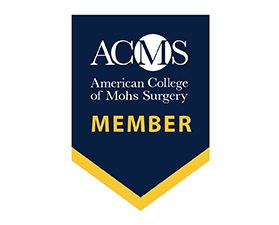Mohs Surgery

At OHSU, our dermatologic surgeons (doctors who are both dermatologists and surgeons) are national leaders in Mohs surgery.
- Each of our Mohs surgeons is a member of the American College of Mohs Surgey.
- All our surgeons completed fellowships. This means they had at least a year of additional advanced surgical training.
- We attract patients from across the Northwest for our experience treating challenging cases with Mohs surgery.
- Our doctors have the skill and experience to perform advanced reconstruction after skin cancer removal.
- We are a rare center that offers Mohs for melanoma in selected cases, most often on the head and neck.
- Our team is doing research to improve the Mohs procedure, ensuring that patients receive the most advanced care possible.
- We are among the few centers to use a special stain (immunohistochemical) that makes melanoma cells visible during surgery. This helps surgeons remove all of the tumor, lowering the risk of cancer coming back.
What is Mohs surgery?
Mohs surgery is named for Dr. Frederic Mohs, a University of Wisconsin professor who started doing the surgery in the 1940s. The surgery is also called Mohs micrographic surgery. It now has up to a 98% success rate, even for skin cancers that have returned. It’s used most often for basal and squamous cell carcinomas.
When is Mohs surgery recommended?
Mohs is often recommended for large tumors, tumors in hard-to-treat places and tumors that have returned. It is also especially recommended for tumors in areas such as the face or ears, where it’s important cosmetically to remove as little tissue as possible.

How Mohs surgery works
At OHSU, this outpatient surgery is done at the Center for Health & Healing Building 1. The affected area is numbed, and one of our specially trained dermatologists or surgeons removes the skin cancer in thin layers. Each layer is inspected under a microscope for cancer cells. The process is repeated until no cancer cells are seen. This method preserves as much healthy tissue as possible.
How long does Mohs surgery take?
The entire process can take several hours. The doctor usually removes one to three layers of skin and tissue. Each layer takes about 20 minutes, not including time to numb the area. It takes about an hour for each layer to be prepared and inspected. The procedure is usually finished in one day but on occasion continues on a second day.

Reconstruction options
Your doctor will discuss options for repairing your surgical wound. Most are done right after the surgery.
Letting the wound heal: In some cases, the wound will heal best on its own. Patients might choose this option knowing they can have the scar corrected later if needed.
Stitches: This might be the best option for small and medium wounds, though scars may be longer than some patients expect.
Skin graft: Skin from near the wound or another part of the body, such as the thigh, is stitched over the wound. Sometimes a wound gets a temporary graft until another cosmetic procedure can be done.
Skin flap: Healthy tissue next to the wound is moved to cover it. When practical, this can offer the best cosmetic result.
Mohs surgery for melanoma
OHSU surgeons have the skills and technology to do Mohs for select melanoma cases.
Normally, melanoma cells are difficult or impossible to see with traditional Mohs methods.
We are among a handful of U.S. centers that use a technique (immunohistochemical staining with MART-1) to see the cells and make sure we remove all of them.
Some patients need an additional visit for reconstruction.
How to prepare for Mohs surgery
Your care team will give you complete instructions. Here are a few things to know:
Preoperative appointment: You may be asked to come in a day before surgery to go over details. Often, though, your care team can go over details and answer questions right before the surgery.
Medications: We ask that you stop taking any aspirin or ibuprofen (Anacin, Bufferin, Advil or Motrin) at least one week before surgery because they can interfere with blood clotting.
Reading material: Because you may have a few hours of waiting, you might want to bring a book or magazine. You will be free to sit in the waiting area with a pressure dressing over your wound while tissue layers are examined.
Comfort: You can have anti-anxiety medication right before surgery if you want but will need a ride home.
Recovery
Your care team will provide additional information. Some things to know:
Pain medication: Most people have little pain. If medication is needed, we advise patients to take acetaminophen (such as Tylenol), and to avoid aspirin and similar products because they can cause bleeding.
Bleeding: The wound bleeds for a few patients. Applying pressure with a gauze pad for 20 minutes once or twice usually solves the problem. Call your doctor if bleeding persists.
Bruising and itching: Swelling and bruising are common, particularly for surgeries near the eyes or mouth. This usually subsides within four or five days. Itchiness or redness around the wound usually goes away within a couple of days.
Numbness: The area around the wound may be numb, possibly for months or longer. Check with your doctor if you’re concerned.
Follow-up visits: You will have follow-up visits until the wound heals. After that, we recommend follow-up visits with a dermatologist every six months for two years, then once a year after that.
Learn more
- Mohs Surgery, Educational Information for Patients
- Mohs Surgery Patient Education, American College of Mohs Surgery
- Mohs Surgery, Skin Cancer Foundation
- Mohs Surgery, The Most Effective Treatment for Skin Cancer, American College of Mohs Surgery
Location
Knight Cancer Institute, South Waterfront
Center for Health & Healing, Building 2, ninth floor
3485 S. Bond Ave. Portland, OR 97239
Free parking for patients and visitors
Refer a patient
- Refer your patient to OHSU Dermatology.
- Call 503-494-4567 to seek provider-to-provider advice.
Cancer clinical trials
Clinical trials allow patients to try a new test or treatment.
Read more
Learn more about OHSU Knight Cancer Institute treatments:
